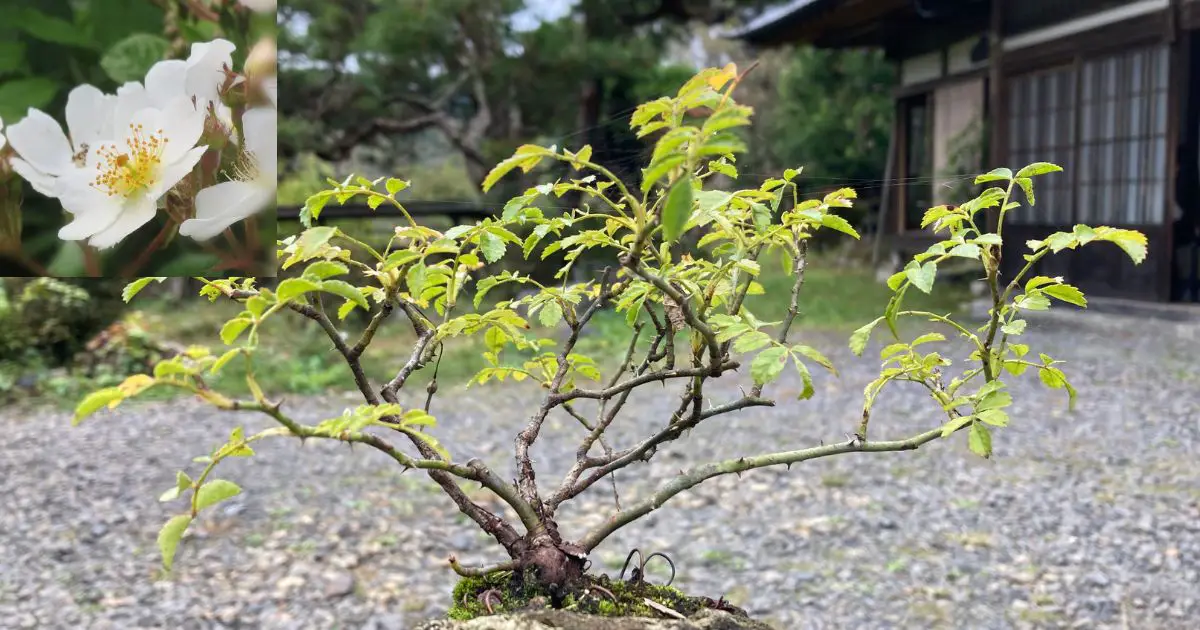Can you bonsai a rose?
Though its history is shorter, rose bonsai are cultivated for the past 150 years. In Japan, wild roses are more popular as rose bonsai than cultivars because they look more “natural” when grown as a bonsai tree.
What makes roses good for bonsai?
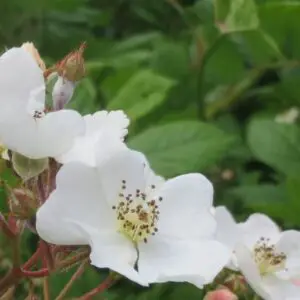
Rosa multiflora
There a quite a few characteristics that make rose a good bonsai.
- Growing rose is very popular among gardeners. You can find one in any gardening stores.
- Rose is easy to propagate by seeds, cuttings, and grafting.
- Rose is relatively easy to grow as a bonsai because it is strong and sturdy. It sprouts strongly and branches ramify finely.
- Rose can be shaped quite freely.
- Life span is long.
- Rose flowers are beautiful and fragrant.
- The color of the new leaves is beautiful in spring and turns red in autumn.
- Roses may bear fruit in fall depending on the variety. Even after the leaves have fallen, fruits remain on the branches.
The biggest drawback is its thorns. There are roses that have thorns on the leaves and buds as well, which can be annoying for bonsai growers. Also, roses are susceptible to diseases and pests, and so they must be constantly disinfected to prevent infestation.
Types of rose to make a bonsai

Rosa multiflora
Since bonsai are grown in small, shallow pots, not every rose is fit for bonsai. But there are hundreds of varieties of roses and you can choose one that has the following characteristics.
- Beautiful flowers blooming in large numbers
- The size of flowers is small enough such that the branches do not bend downwards when the flowers bloom, and in proportion to the overall height of the tree.
- Small leaves
- Good ramification and dense foliage
- Sturdy branches that grow without support
- Smaller and fewer thorns are preferable.
Wild roses such as Nootka rose and Virginia rose are a good choice. Miniature roses and shrub roses are also good candidates.
Rose bonsai care
| Cold tolerance | Strong∗ |
| Heat tolerance | Strong∗ |
| Drought tolerance | Fairly high∗ |
| Sun exposure | Full sun to partial shade |
| Soil mix | Akadama: 50% Sand: 40% Organic compost: 10% |
| Fertilization | 2-3 times in March, Apr, May, June, Sept, Oct |
| Watering | Once /day in spring and fall 2-3 times/day in summer Once every 3-4 days in winter |
∗ Depends on the variety.
Placing

The rose family are sun-loving plants and prefers full sun. A sufficient amount of sunlight (minimum 6 hours/day) is not only necessary to produce flower buds (and fruiting) but also to make shorter internodes. Keeping rose bonsai in shade tends to elongate branches.
Rose bonsai thus should be placed outdoors where it has plenty of sunlight and airflow. In especially hot climates, it will do better if the tree is protected from the strong afternoon sun in midsummer.
Repotting
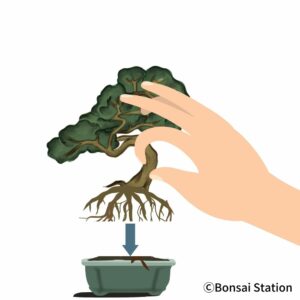
How often to repot
Rose bonsai should be repotted once a year.
Roses sprout earlier than other plants and continue to grow until late fall. Due to the longer growing period, they get rootbound in 2 to 3 years. The roots will fill the pots, causing old branches to die and the roots to form knots, which will severely inhibit growth.
When to repot
The best time to repot a rose bonsai is early spring when the buds are just beginning to emerge. If you miss this timing, it will be too late to repot. Delayed repotting can adversely affect growth.
Best soil mix for rose bonsai
The best soil mix for rose bonsai is;
-
- Akadama: 50%
- Sand: 40%
- Organic compost: 10%
The soil should have good water retention as well as drainage. As roses need a lot of water in warmer season, a slightly deeper pot will save you the trouble of irrigating in summer.
How to repot
- Pull the tree out of the pot and loosen all the old soil, first from the bottom and then from around the edges.
- Prune thick/old roots while avoiding cutting fine roots.
- Put a layer of large grain soil (eg. pumice) on the bottom of the pot for drainage.
- Place the tree in the pot and fill it with soil mix.
After repotting, water well and move the tree to a warm place with little wind for 1 to 2 weeks until it takes root. During this time, make sure not to let the soil dry out, and water it before it completely dries out.
Watering

As a general guide, rose bonsai should be watered;
- Once/day in spring and fall
- Twice or three times/day in summer
- Once every 3 to 4 days in winter
Watering adequately is an important factor in growing healthy rose bonsai. Roses typically love water but they can be drought tolerant once established. The balance is important: overwatering is not good, but underwatering is also bad.
Rose leaves should not be wilted due to underwatering even for a day, especially before flowering because rose bonsai may not bloom at all if the tree lacks water for some time. Give a little more water to the extent that the soil is not too humid.
On the other hand, if the soil is always wet, only shoots (long branches) grow and the number of flowers decreases. Wet soil may also cause root rot. So again, adequate watering is important.
Fertilizing
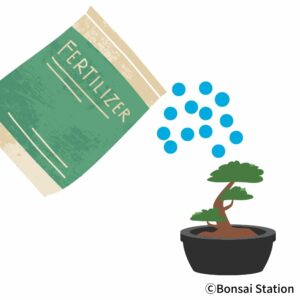
Roses like fertilizer. But if you give them too much, only a few shoots grow vigorously and not the rest of the existing branches. The point is to give it a moderate amount continuously.
Start fertilizing with a very diluted liquid fertilizer (2x) 2 to 3 weeks after repotting. Then give once every two weeks. Stop fertilizing during continued rainfall, if any, and hot summer.
Start fertilizing again in late summer until the end of October, giving a little more concentrated one than in spring. Fall fertilizing is important to store energy to get over the winter and for the next year’s sprouts.
Pruning
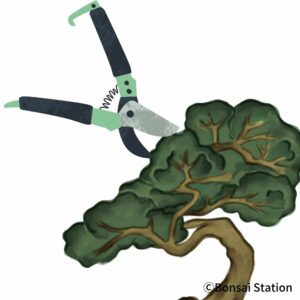
Pruning should be done twice a year in March and September. Get rid of branches that are too elongated, dead, or weak.
Keep in mind that rose flowers grow at the tips of new shoots that grow in the same year. So, if you cut off all the new shoots, no flowers bloom that year. If you are not sure which to prune, the best timing is after flowering.
Roses tend to produce multiple shoots vigorously and the foliage becomes dense. Sort out leaves and branches to be adequately spaced apart to allow air to flow inside the foliage.
Styling
Pinching
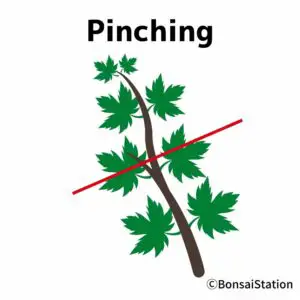
Pinching
Pinching (tipping) is a pruning method to encourage ramification.
Do not pinch shoots blindly because all roses bloom at the tips of shoots. So, it is best to let the shoots grow until around May or June. Check whether buds have formed, and decide to pinch or leave depending on the overall shape of the tree.
Keep pinching throughout the growing season to get finer ramifications.
Defoliation
Defoliation should be done when the growth is vigorous and the leaves become too large as a bonsai, or the tree lacks ramification. The best time for defoliation is around the end of spring. Cut off the lamina (leaf blades) leaving only the petioles.
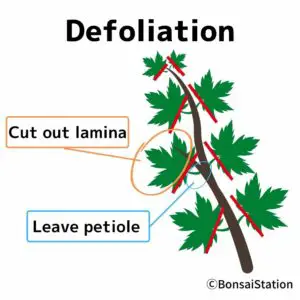
Full defoliation
The rose bonsai after defoliation can be put back on the outdoor shelf. On sunny days, give plenty of mist once a day to encourage new shoots. The second shoots will come out in about a week.
After defoliation, the number of branches and leaves increases, and at the same time, the size of the leaves becomes smaller. It also suppresses the growth of elongated branches.
However, defoliation is very stressful for the bonsai tree. It can weaken the tree to the point where it cannot produce new shoots. Choose a tree that is healthy and fertilize them very well before doing this procedure.
To obtain in-depth knowledge about defoliation, the following posts may be helpful.
Wiring
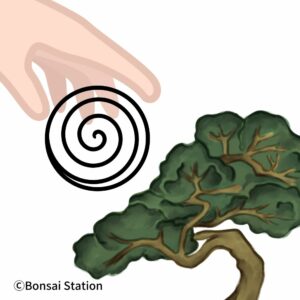
The best time for wiring a rose bonsai is around the end of spring when the branches are soft and elastic. Be sure to wrap the wire to protect the branches before wiring.
Remove the wire in fall before it eats the skin. If the wire is left too long, it will eat the bark and make a scar that may never heal. If the shape is not set by then, try wiring again next year.
Infestation

Rose family plants are quite susceptible to diseases. So, maintaining a good growing environment (sunlight and airflow) to keep the bonsai tree healthy and regular disinfection are both essential.
Insects
Aphids and leaf mites are likely to occur in spring when the climate is getting warmer. Sawflies (wasp worms) and caterpillars might also infest rose bonsai trees.
Spraying insecticides once or twice a month (follow the label on the package) during the growing season is a good preventive measure because once an outbreak occurs, it cannot be completely suppressed by one or two pesticide sprays.
Diseases
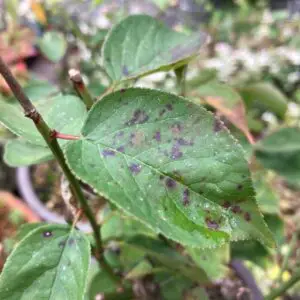
Black spot
Black spot, rose rust and powdery mildew are the most common rose diseases.
Black spot is a fungal disease where black spots appear on the leaves which drop early. Rose rust is also a fungal disease producing small orange/black spots on the stems and leaves.
Fungicides can be used to control the disease. If the infested tree is vigorous (or was vigorous before the disease), you can also defoliate all leaves and sterilize the tree.
Caring in extreme weather

Rose cultivars are weaker than wild roses, so exposure to cold wind or frost/snow may cause the branches to die in winter. In this case, it is necessary to move the bonsai to a sunny, windless location. When the climate starts to get warm in the spring, move the bonsai trees outside to a warmer shelf.

